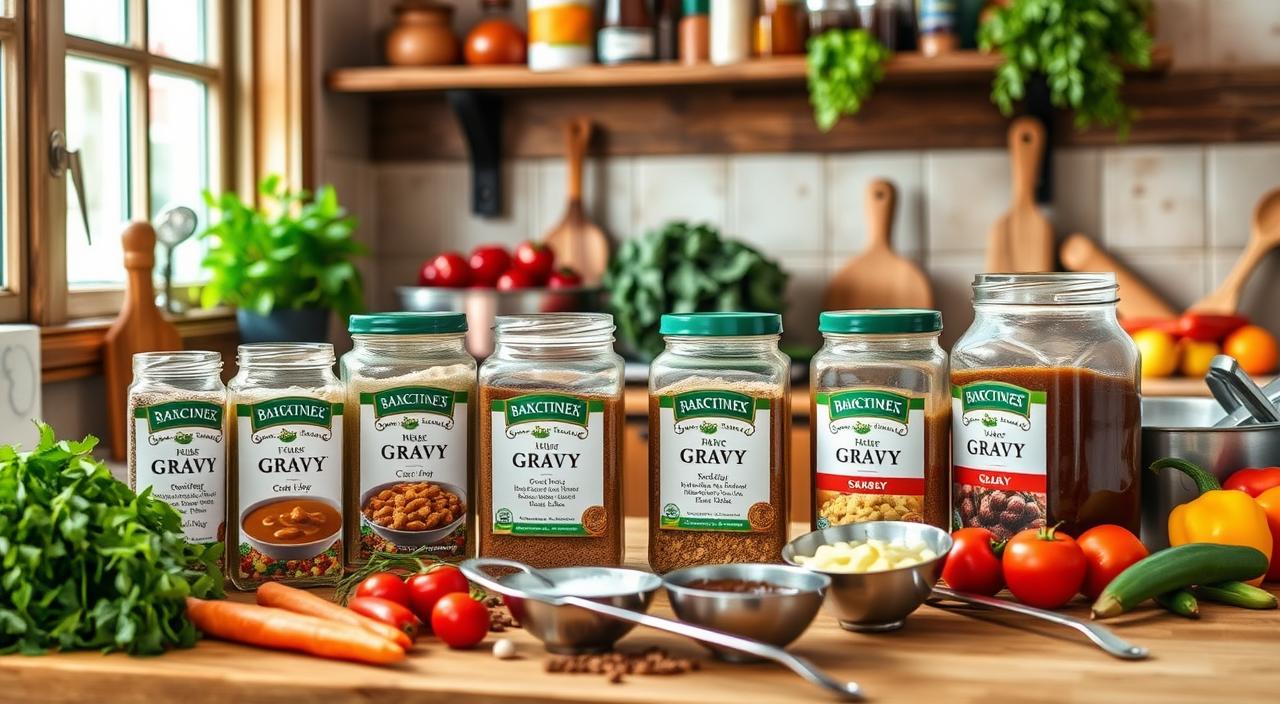In today’s world, sodium-free gravy mixes are key for those who care about their health and taste. They’re perfect for anyone on a low-sodium diet or just looking for healthier cooking options. These recipes are not only tasty but also loved by the whole family.
They offer a way to enjoy rich flavors without worrying about your diet. Let’s dive into making heart-friendly gravy that makes your meals even better!
Key Takeaways
- Healthy alternatives to traditional gravy can enhance flavor without added sodium.
- Easy gravy mix recipes make it simple to prepare delicious, heart-friendly dishes.
- Sodium-free gravy supports dietary restrictions while ensuring enjoyment of meals.
- Experimenting with flavors and thickeners can produce delightful variations.
- A focus on wholesome ingredients is key to successful sodium-free cooking.
Introduction to Sodium-Free Gravy
Sodium-free gravy is a tasty and healthy choice instead of regular gravies full of salt. It uses spices, herbs, and natural thickeners instead of salt. This makes it great for those looking for low-sodium options without losing flavor.
People with heart issues or high blood pressure can benefit from less sodium. Sodium-free gravy helps them enjoy tasty meals without the worry of too much salt. It adds flavor to dishes like mashed potatoes and turkey, making every bite satisfying.
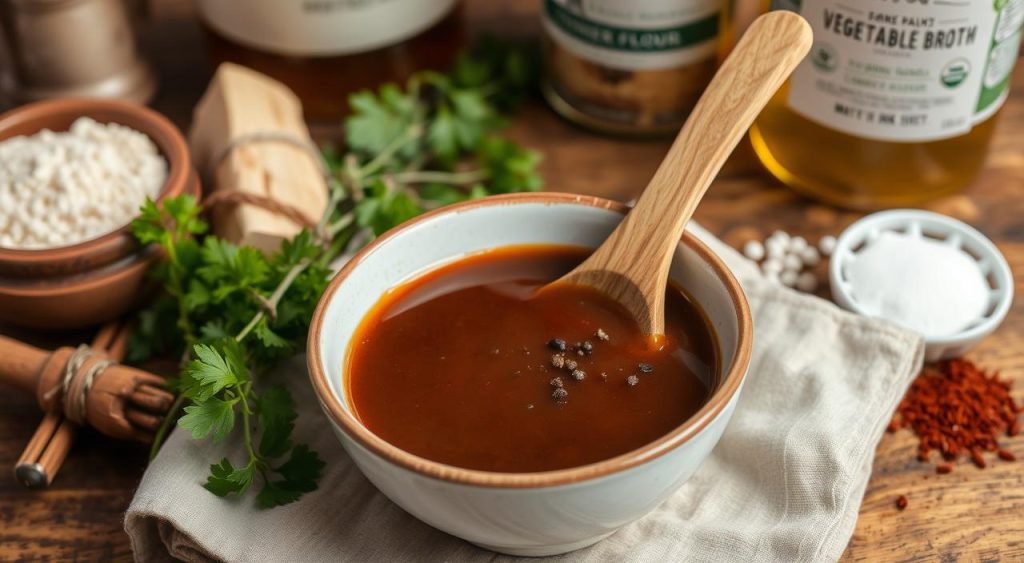
Using sodium-free gravy in cooking is easy and fun. It can be used in many dishes, thanks to a little creativity and the right ingredients. Choosing sodium-free options helps lead to a healthier lifestyle. It makes it easier to enjoy favorite dishes without worrying about too much sodium.
Benefits of Cooking with Sodium-Free Gravy
Cooking with sodium-free gravy has many benefits. It’s great for those who care about their health. One key advantage is it can help lower blood pressure. Too much sodium can harm your heart, but using low-sodium gravies can help.
Using sodium-free gravies makes your food taste good without harming your health. The healthy cooking benefits go beyond just taste. They help you eat well and fit different diets, like gluten-free and vegan.
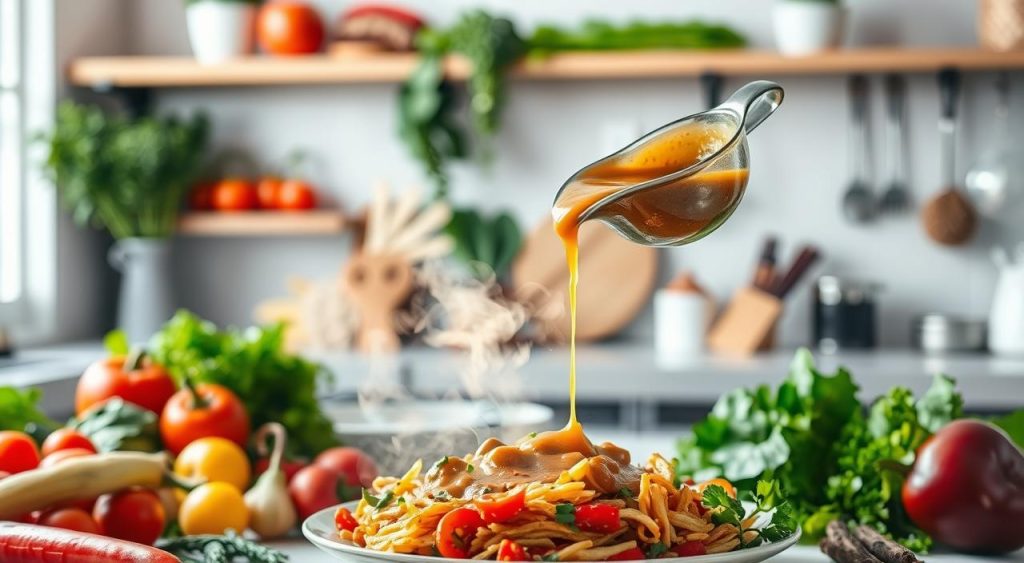
Sodium-free meal preparation lets you get creative in the kitchen. These gravies add flavor to many dishes without the bad effects of regular gravies. This makes sodium-free gravy a key part of cooking today.
Health groups say eating less sodium is good for you. By choosing advantages of sodium-free cooking, you’re not only getting healthier. You’re also making meals that are tasty for everyone.
Essential Ingredients for Sodium-Free Gravy Mix
Making a tasty sodium-free gravy mix needs the right ingredients. Knowing the best ingredients for a flavorful sauce is key. We’ll look at common thickeners and flavor enhancers that don’t add sodium.
Common Thickeners Used
Thickeners are crucial for gravy, giving it the right consistency. Here are some top picks:
- Cornstarch: A classic thickener that makes gravy smooth.
- Arrowroot Powder: A gluten-free option that thickens well at lower temperatures.
- Flour Alternatives: Gluten-free flours like almond or coconut flour thicken and add flavor.
Flavor Enhancers Without Sodium
Adding flavor without sodium means getting creative with herbs and spices. Here are some great options:
- Garlic Powder: Brings a strong flavor that goes well with many dishes.
- Onion Powder: Adds sweetness and depth, a kitchen staple.
- Black Pepper: Adds a nice kick and boosts savory flavors.
- Nutritional Yeast: Gives a cheesy, umami taste, making gravies richer without salt.
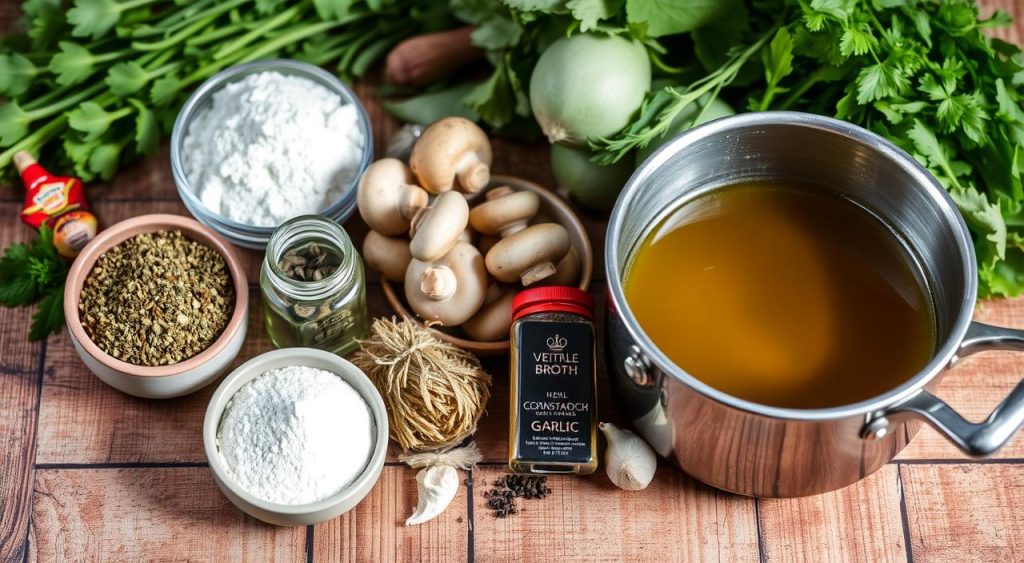
Recipes for Sodium-Free Gravy Mix
Making delicious sodium-free gravy at home is simple. It’s great for breakfast or dinner. These recipes are easy to make and taste amazing.
Classic White Gravy Recipe
This white gravy is perfect with biscuits or fried chicken. You’ll need:
- 2 tablespoons of cornstarch
- 2 cups of low sodium vegetable broth
- 1/2 teaspoon of black pepper
- 1/4 teaspoon of garlic powder
- 1/4 teaspoon of onion powder
To make it:
- Whisk cornstarch with some broth until smooth.
- Add the rest of the broth and spices, stirring constantly.
- Simmer until it thickens, about 5-7 minutes.
Rich Mushroom Gravy Recipe
This mushroom gravy is full of flavor. You’ll need:
- 8 ounces of mushrooms, sliced
- 2 tablespoons of cornstarch
- 2 cups of low sodium vegetable broth
- 1 teaspoon of dried thyme
- 1 tablespoon of olive oil
To prepare it:
- Heat olive oil and sauté mushrooms until soft.
- Whisk cornstarch with broth, then add the rest of the broth and thyme.
- Pour the mixture into the saucepan and cook until thickened, about 10 minutes.
Herb-Infused Gravy Recipe
This herb-infused gravy adds a fresh twist. You’ll need:
- 2 tablespoons of cornstarch
- 2 cups of low sodium vegetable broth
- 1 teaspoon of mixed dried herbs (such as rosemary, sage, and basil)
- 1/4 teaspoon of black pepper
To prepare it:
- Whisk cornstarch with a bit of broth until smooth.
- Combine the rest of the broth and herbs in a saucepan and bring to a gentle boil.
- Stir in the cornstarch mixture, reduce heat, and simmer until thickened, approximately 6-8 minutes.
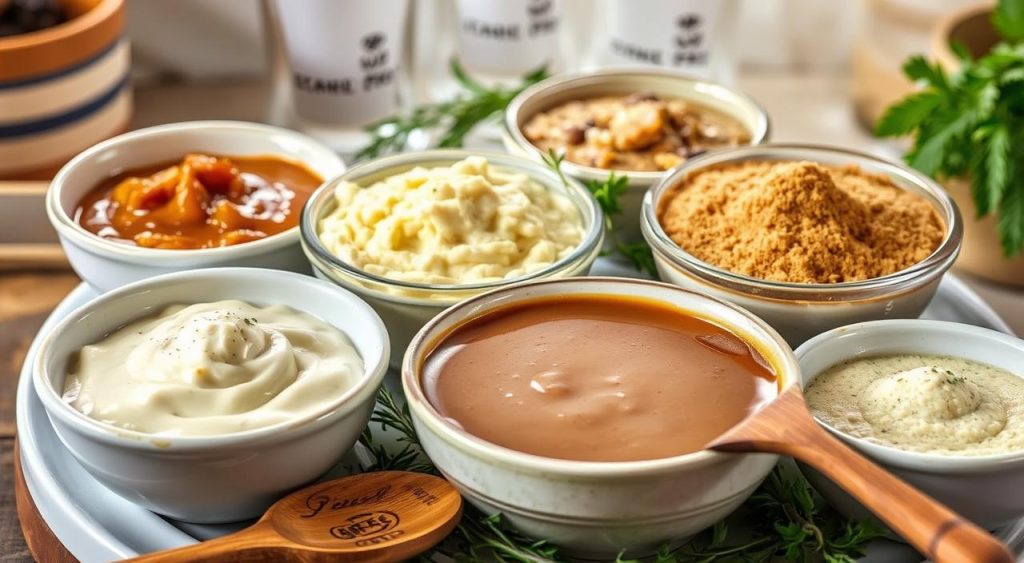
Tips for Making the Perfect Gravy
Making a tasty sodium-free gravy needs careful attention. Every part must work well together. Expert tips for gravy making help create a great taste and texture. Choosing the right gravy base and using the right techniques are key steps.
Choosing the Right Base
The base of a great gravy is crucial. Choose stocks or broths that are low in sodium but full of flavor. Homemade broths are rich, but you can also find good store-bought ones. Look for “low sodium” labels.
Adding roasted vegetables can boost flavor without salt. For tips on making homemade gravy, see this guide.
Techniques for Achieving the Right Consistency
Learning perfect gravy techniques is important. Begin with a roux of flour and fat. Slowly add your broth, whisking well to avoid lumps.
Keep the temperature steady and whisk constantly. If it’s too thick, add more broth or water. Cooking it for the right time lets flavors blend well. Watch your pot closely. For more recipe ideas, visit this page.
Using Gravy Mix in Everyday Cooking
Adding gravy to meals can make them taste better. Sodium-free gravy mix is great for many dishes. It makes cooking easier and adds flavor, perfect for home cooks.
Gravy mix is great in casseroles. Just mix it with your ingredients for a rich flavor. It’s also good in soups, making them creamy and filling.
Gravy mix isn’t just for casseroles and soups. It’s also good on meats like chicken, turkey, or beef. Drizzling it on can make a simple meal delicious. You can also add it to veggies for a tasty side dish.
Using gravy mix saves time in the kitchen. It’s quick to make, perfect for busy nights. It also fits many diets, making meals enjoyable for everyone. Discover how gravy mix can make cooking fun and easy.
Pairing Your Sodium-Free Gravy with Dishes
Finding the right combinations can greatly enhance the dining experience. When it comes to sodium-free gravy, knowing the ideal pairings for gravy makes a significant difference in flavor profiles. Below are some recommendations for meats and vegetables that go well with this versatile sauce.
Best Meats to Complement Your Gravy
Selecting the appropriate proteins can elevate your sodium-free gravy to new heights. Here are some meats that go with sodium-free gravy:
- Turkey – A classic choice, particularly during the holidays. Its tenderness pairs perfectly with rich gravy.
- Chicken – Whether roasted or pan-seared, chicken adapts well and balances the savory notes of the gravy.
- Beef – A hearty option, perfect for a comforting meal with richness that complements various gravy types.
Vegetable Pairings That Elevate Flavor
Incorporating vegetables enhances gravy flavors significantly. Here are some top picks:
- Leafy Greens – Spinach, kale, or collard greens offer a nutrient-rich option, adding a slight bitterness that contrasts nicely with the gravy.
- Root Vegetables – Carrots, potatoes, and turnips absorb gravy beautifully, enriching every bite.
- Mushrooms – Their umami flavor deepens the overall taste, making them a fantastic addition alongside meats.
Storing and Reheating Your Gravy Mix
Storing gravy right is key to keeping its taste and texture. There are several ways to store gravy, keeping it tasty for a while. Refrigeration is a common method, allowing your gravy to stay good for up to three days. Always put it in an airtight container to keep moisture out.
Freezing is another great way to keep gravy fresh for longer. It can last in the freezer for two to three months. Use containers or bags made for the freezer, leaving room for expansion. Don’t forget to mark the containers with the date you stored them.
Reheating gravy right is important to get it back to its original state. Start by thawing frozen gravy in the fridge overnight. To reheat, use a saucepan over low heat. Stir constantly to avoid sticking.
If the gravy gets too thick, a little broth or water can fix it. This will help it reach the right consistency again.
- Always taste the gravy after reheating and adjust seasoning if needed.
- Avoid using a microwave as it can cause uneven heating and alter the texture.
- If reheating multiple servings, do so in batches to maintain even warmth.
Frequently Asked Questions About Sodium-Free Gravy
More people are looking for healthier cooking options, including sodium-free gravy. They have many questions about how to make and use it. This section will answer some common questions and offer useful tips.
What are the health benefits of sodium-free gravy? Sodium-free gravy can help control blood pressure and lower heart disease risk. It’s a tasty way to eat healthy without too much sodium.
People often wonder about gravy preparation:
- Can sodium-free gravy still taste good?
- How long can I keep my homemade gravy in the fridge?
- What spices and herbs can I use to add flavor without sodium?
To answer these, using herbs like rosemary, thyme, and paprika can make your gravy rich. Homemade gravy can stay good in the fridge for up to 3 days.
For those with cooking questions, following dietary guidelines is key. Learning new ways to cook healthy food without losing flavor is important.
Conclusion
Sodium-free gravy offers many benefits, making it a great choice for your cooking. It adds flavor to your meals and helps you eat healthier. You can enjoy tasty dishes without worrying about too much sodium.
With recipes like Classic White Gravy and Rich Mushroom Gravy, you can cook delicious, healthy meals. This article encourages you to try new things in the kitchen. It shows how easy it is to make healthy, tasty food.
Trying sodium-free recipes can make your meals better and improve your cooking skills. It’s a way to eat well without sacrificing flavor. Remember, you can be healthy and still enjoy great food.
Creating hearty gravies that are good for you is rewarding. These gravies make your favorite dishes even better and help you stay healthy. Try these recipes and see how they can make your meals special. For more summer ideas, check out delicious summer recipes that are both healthy and tasty.
FAQ
What is sodium-free gravy?
Sodium-free gravy is a healthier choice compared to regular gravy. It doesn’t have added salt or sodium. This gravy is great for those who need to watch their diet or want to eat heart-friendly foods.
What are the benefits of using sodium-free gravy?
Using sodium-free gravy can help lower blood pressure and support a balanced diet. It’s also good for heart health. It adds flavor to meals without the risks of high sodium, making it good for many diets, including gluten-free and vegan ones.
How can I thicken gravy without sodium?
You can thicken gravy without sodium using cornstarch, arrowroot powder, or flour alternatives. These ingredients help achieve the right consistency without adding salt.
Can I prepare sodium-free gravy in advance?
Yes, you can make sodium-free gravy ahead of time. Store it in the fridge for a few days or freeze it for longer. Use airtight containers to keep the flavor and texture fresh.
What are some flavor enhancers I can use in sodium-free gravy?
To enhance flavor without sodium, use herbs and spices like garlic powder, onion powder, black pepper, and nutritional yeast. These ingredients boost the taste of the gravy while keeping sodium low.
How long does sodium-free gravy last when stored?
Sodium-free gravy can last 3-4 days in the fridge. If you freeze it, it stays good for up to 3 months. Always heat it well before eating.
What dishes pair well with sodium-free gravy?
Sodium-free gravy goes well with many dishes, like roasted meats, mashed potatoes, casseroles, and veggies. It’s especially good with turkey, chicken, and root vegetables, making meals complete.
Are there ready-made sodium-free gravy mixes available?
Yes, you can find sodium-free gravy mixes in stores. They offer convenience and taste. Just make sure to check the ingredients for hidden sodium.
How can I adjust the consistency of my sodium-free gravy?
To change the gravy’s consistency, add more thickening agents or liquid. For thicker gravy, whisk in cornstarch slurry slowly. For thinner gravy, add more broth or water gradually.

